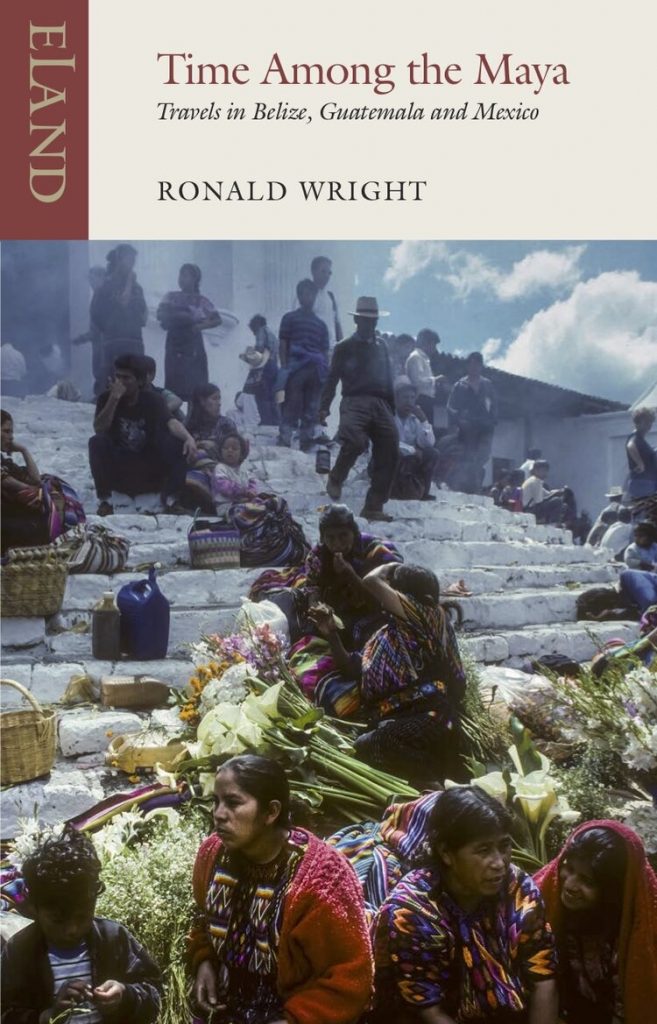
“If Greek civilization explored the universe with geometry, the Maya did so with arithmetic and time.”
This insight comes early in Ronald Wright’s Time Among the Maya, and it sets the stage for his journey through Belize , Guatemala, Chiapas and the Yucatán.
Like the Mayan calendar, the narrative ranges through vast spans of time, from distant prehistoric beginnings to the heyday of powerful city-states, and to the late 1800s Caste War between Latinos and Maya that left isolated villages of survivors in Quintana Roo who maintained their stubborn independence well into the 1980s.
Far from being an extinct people swallowed by the jungle like their famous temples, the Maya make up a significant percentage of the population of southern Mexico, Guatemala and Belize, with vibrant ancient languages that are still spoken today.
This beautifully written account of contemporary Maya culture will help you understand a remarkable people who “didn’t contemplate eternity with mere metaphors, they actually ran the calendrical mechanism back and forth over immense spans of the past and future, apparently to stress symmetries between human and godly time.”
As he visits ancient sites in the region, the author builds the most accessible explanation I’ve ever read of the complex calendar system, with its Long Count, and its ceremonial cycles — the 260-day Tzolkin that acts as almanac, horoscope and religious calendar, and the 18,980 day Calendar Round with its Year Bearers — and how it shape their unique way of seeing the world.
“Contact with the past defines the present and the future,” he writes, “the mechanism for such contact is the calendar.”
Wright also meets highland Maya who continue to make offerings at these ruins, governed by the cycles of ancestors who never completely vanished, they just faded into the background.
But this is far from a vast digression into esoteric arithmetic. Like the best travel writing, Time Among the Maya blends contemporary culture and ancient history, anthropology and literature, and interesting encounters with those he meets along the way.
Wright’s journey took place in 1980s, but his observations feel surprisingly contemporary. Many of the same issues still afflict Mesoamerica — extreme poverty, environmental degradation, plagues of missionaries, civil strife made worse by abusive militaries — and cycles of violence continue to recur like the cycles of the Maya calendar.
I traveled the region in 2000, and his descriptions of Guatemala, the Petén and Belize were still accurate then.
The book also contains a stark warning for readers today.
Modern Quiché daykeepers — shaman who keep the Mesoamerican calendar — say, “He who makes an enemy of the Earth makes an enemy of his own body”.
“The Maya shaman-priest who said that put his finger squarely on the force that animates and will probably destroy our civilization,” Wright says:
“The Judeo-Christian (and Muslim) tradition is founded on the belief that the earth is a kind of machine put here by God for the use and testing of man. Animals are little machines without souls over whom Adam and Noah were given dominion, to treat as they saw fit. No moral obligations or reverence are owed to the beasts of the field, much less to the forests and grasslands, lakes, rivers, and the earth itself. In their attitude to the physical world, and the denial of the old nature gods, Judaism, Christianity, and Islam are the first materialism. The planet is a vale of tears, necessary for man’s sustenance but potentially hazardous to his soul. He can use it but he must not love it.”
That’s the danger in the loss of culture, isn’t it? When a culture dies, an immense body of human knowledge, gathered by generations of minds, vanishes into oblivion.
We’re left with Silicon Civilization. Modernity run amok, cascading downhill with self-serving momentum as we live out increasingly harried lives in a sound bite, cell phone, attention-deficit sprint from cradle to grave.
The Maya knew that even the most powerful civilizations rise and fall. But they also knew how to fade into the background and wait for the next tzolkin. We may erase ourselves from the Earth, but we cannot erase time.
Buy a copy from Eland today ==> Time Among the Maya
